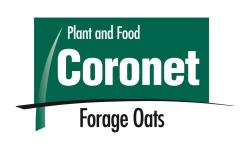Coronet
HIGH QUALITY HIGH UTILISATION.

Coronet is a new forage oat suitable for grazing or silage, bred to replace Hokonui. Coronet has been bred for improved disease tolerance, high leaf to stem ratio and extreme winter hardiness.
- Rust tolerant
- Late maturing
- Frost/cold tolerant
- High leaf to stem ratio
- Very high yielding for grazing or green chop silage
These characteristics make Coronet the ideal cultivar when quality winter or spring feed is required. Coronet has excellent disease tolerance and is a later maturing oat thus maximising the quality and yield potential of the crop. Coronet is ideal for producing green chop silage (cut at boot stage), but is less preferred for whole-crop cereal silage.
Coronet can be either autumn or spring sown. Autumn sown Coronet is the ideal forage oat for winter sheep grazing, to be sown after maize or summer brassica crops. The earlier Coronet is sown in the autumn, the larger the potential yield of the crop will be.
Spring sown Coronet can be planted in the gap between the finishing of winter crops and thest art of the spring sown pastures or crops, as it provides a large amount of high quality feed in
spring for silage. The ideal time to harvest Coronet for maximum yield and quality is when the crop is at the boot stage.
Care must be taken if using high rates of nitrogen as, with any other quick growing winter forage crops, nitrate poisoning can occur. Stock monitoring is required in the initial stages of grazing. To reduce risk of nitrate poisoning, do not graze within one month of nitrogen application.
.jpg&Format=jpg&Height=678&Compression=75&Crop=5)


Read a case study
Agricom Case Studies
